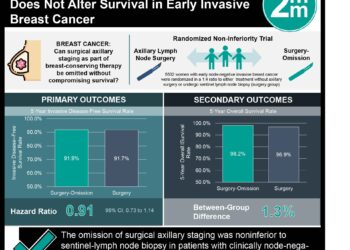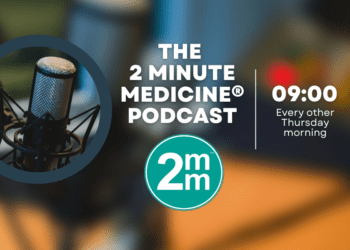2 Minute Medicine Rewind August 28, 2023
1. This analysis of a prospective cohort of moderate and late preterm (MLPT) children found both MLPT-specific and MLPT-sex-specific neurodevelopmental delays. The gross motor and personal-social domains of development were most affected, particularly in males.
2. Two placental genes, apolipoprotein E (APOE) and cystatin c (CST3), were identified as predictive of neurodevelopmental delay in MLPT children and postulated to be part of a placenta-brain axis in fetal development.
Evidence Rating Level: 2 (Good)
Preterm birth is defined as delivery before 37 weeks gestation according to the World Health Organization. However, the degree of preterm status is also an important factor in risk stratification for both mother and fetus. The literature surrounding extreme preterm (< 28 weeks) and very preterm (28 to 31+6 weeks) births is more robust than that of moderate and late preterm (32-36 weeks) births. Some more recent literature is now exploring the potential morbidity and mortality of MLPT births, as they account for a strong majority of births globally. The current analysis of a prospective cohort of 129 MLPT infants and 3136 full-term (FT) controls assessed neurodevelopmental outcomes associated with MLPT, as well as potential placental genes contributing to changes in fetal brain development (coined the “placenta-brain axis”, PBA). The Ages and Stages Questionnaire of China (ASQ-C) was used at 6, 18, and 48 months of life to assess five domains of development. Gross motor (OR = 0.58, p = 0.006) and personal-social development were significantly delayed (OR = 0.61, p = 0.013) in MLPT infants. Interestingly, delays were more pronounced in males. MLPT males were significantly delayed in gross motor (OR = 0.56, p = 0.033), fine motor (OR = 0.56, p = 0.018), and personal-social domains (OR = 0.60, p = 0.021). Significant delays when adjusting for confounding variables were not found in MLPT females, although preliminary analyses supported delays in gross motor and personal-social domains. Placental tissue was also collected and sequenced in a transcriptome-wide analysis. There were 709 upregulated and 65 downregulated genes that differed between MLPT and FT males (86 upregulated and 398 downregulated for females). Only a few overlapped between the male and female groups, possibly bolstering sex-specific findings. Fourteen PBA genes (two in all MLPT, nine in male MLPT, and four in female MLPTs) were identified for further analysis. Machine learning allowed for the building of predictive models with genes. The APOE and CST3 genes outperformed the logistic regression and decision tree models and were found to be good predictors of neurodevelopmental delay in MLPT children (Area Under the Curve = .861 and .833, respectively). Overall, this study’s findings suggest a more sex-specific interaction between MLPT birth and neurodevelopmental delay, and two genes were identified as placental biomarkers. Further in vivo and in vitro experiments may yield more information on genetic biomarkers such as APOE and CST3.
Physician Antimicrobial Prescribing and Patient Outcomes on General Medical Wards: A Multicentre Retrospective Cohort Study
1. In a retrospective analysis of a cohort of general internal medicine physicians, it was found that antimicrobial prescribing was 30% higher in the 4th quartile compared to the 1st quartile, indicating considerable variability in physician prescribing.
2. Variation in antimicrobial prescribing did not predict clinical outcomes after discharge, but in-hospital mortality was associated with higher intensity prescribing for antimicrobials.
Evidence Rating Level: 2 (Good)
The concept of antimicrobial stewardship among medical professionals is well-established, and preventing overuse is widely recognized as the most feasible way to prevent increasing levels of antimicrobial resistance on a global scale. However, physician-level variability in prescribing choices does bring with it the potential for long-term harms. The current retrospective cohort study of 124 physicians and 124,158 patient admissions evaluated these variations among patients admitted to general medicine wards in Toronto, Canada. Data spanning from 2010 to 2019 were extracted from four major Toronto hospitals via the General Medicine Inpatient Initiative (GEMINI), a highly reliable and accurate database. The primary measure used was days of therapy per 100 patient-days. The proportion of antimicrobial-free days was also calculated for each physician. The variability in the spectrum of prescribing was also assessed. The median physician percentage of antimicrobial-free days was 62.3%. The difference in mean prescribing between physicians in the 1st and 4th quartiles was 15.8 days of therapy per 100 patient-days. Median prescribing was 30% higher in the 4th quartile compared to the first. No significant differences were found for outpatient clinical outcomes when assessed based on physician quartiles of prescribing. Only in-hospital mortality was associated with the intensity of antimicrobials prescribed (OR 1.132, 95% CI 1.035–1.239). While there is naturally an acceptable amount of variation that exists in antimicrobial prescribing, the current study demonstrates that outcomes for patients did not improve for those clinicians in the highest quartiles for prescribing. This indicates that there is still an opportunity to improve stewardship without compromising patient outcomes. While limitations in data collection exist for this study, it is one of the few that has assessed physician variability in antimicrobial prescribing in general medicine wards.
1. This post-hoc analysis of the AMATERASU randomized clinical trial found that, for digestive tract cancer patients with positive p53-immunoreactivity, 2000 IU/day vitamin D3 supplementation resulted in significantly improved relapse-free survival at 5 years.
Evidence Rating Level: 1 (Excellent)
Recent meta-analyses of randomized clinical trials have found that daily vitamin D3 supplementation benefited cancer mortality. In this posthoc subgroup analysis of the AMATERASU randomized, double-blind, placebo-controlled clinical trial, patients with digestive cancers were followed up for a median of 3.5 years to compare the effects of vitamin D3 (2000 IU/day) supplementation with placebo. A participant pool of 392 patients included 183 patients with colorectal cancer, 170 patients with gastric cancer, 37 with esophageal cancer, and 2 with small bowel cancer. Within the subgroup of 80 patients who were found to be p53 immunoreactive, a 5-year relapse occurred in 16.7% of vitamin D group patients compared to 53.8% of the patients in the placebo group (p = .005). Relapse-free survival at 5 years was also significantly higher in the vitamin D group (13 patients, 80.9%) than the placebo group (1 patient, 30.6%; HR, 0.27; 95% CI, 0.11-0.61; p = .002; estimated power > 0.99). The difference remained significant after adjusting for relative levels of p53, age, and history of cardiovascular disease. However, in patients who were not p53 reactive, findings were no longer significant, with 22.2% and 21.1% of patients experiencing relapse or death in the vitamin D and placebo groups, respectively. Relapse-free survival was essentially identical in both groups (HR, 1.09; 95% CI, 0.65-1.84). This study suggests potential benefits for vitamin D supplementation in digestive tract cancer patients who are p53-antibody positive (serum and immunohistochemical tissue staining), but could not support this hypothesis for patients who were not p53-antibody positive. While there are some limitations to this study, results are encouraging and future research on both vitamin D supplementation as well as targeted p53-antibody therapies should be explored.
Oral Lipid Nanocrystal Amphotericin B for Cryptococcal Meningitis: A Randomized Clinical Trial
1. This randomized clinical trial found that an oral lipid nanocrystal (LNC) formulation of amphotericin B was no less effective in the treatment of cryptococcal meningitis in patient cohorts with Human Immunodeficiency Virus (HIV). Early fungicidal activity in the cerebrospinal fluid was comparable among both experimental and control groups.
2. LNC also demonstrated higher tolerability compared to intravenous (IV) amphotericin, as well as a comparable safety profile.
Evidence Rating Level: 1 (Excellent)
HIV and acquired immune deficiency syndrome (AIDS) predisposes sufferers to opportunistic infections. Among the most common of these is a fungal infection, cryptococcal meningitis. Although over 50 species of cryptococcus exist, C. neoformans, a yeast found in pigeon droppings, and C. gattii, cause the majority of infections in humans. Without treatment, cryptococcal meningitis is fatal. Intravenous (IV) Amphotericin B has long been the gold standard of treatment, however, a new oral formulation of amphotericin has recently been developed. The current randomized clinical trial tested oral lipid nanocrystal (LNC) amphotericin B (MAT2203, Matinas Biopharma) to assess its comparable safety, tolerability, and efficacy compared to the gold standard. Arm 1 received oral LNC + flucytosine with (n = 40) or without (n = 40) 2 IV loading doses, and controls received IV amphotericin + flucytosine (n = 41). Cerebrospinal fluid early fungicidal activity (CSF EFA; CSF cryptococcus clearance rate) was not statistically significantly different between the LNC and IV amphotericin regimens. Rates of 18-week survival were 85% in both the IV amphotericin group and all-oral LNC amphotericin, and 90% in the LNC amphotericin with 2 IV loading doses. There was a decrease of 4.6% in absolute risk difference in mortality for the LNC + 2 IV loading doses group (95% CI: −18.9% to 9.6%). The tolerability of LNC was excellent, and toxicities were significantly reduced in the LNC group compared to the IV amphotericin control group. Clinical AEs (41% LNC amphotericin vs. 56% controls) and serious AEs (26% LNC amphotericin vs. 27% controls) were the same among the control and experimental groups. In controls, potassium AEs occurred more than three times as often (p = .04), new onset anemia occurred more than nine times more frequently, mild nephrotoxicity within 6 weeks occurred twice more often than the LNC + 2 IV loading dose group, and four times more often than the LNC oral only group. Overall, these results indicate that antifungal activity in CSF was similar among both the oral and IV groups, all while maintaining a sound safety and tolerability profile. Future studies should explore the administration of LNC in other opportunistic fungal infections, which could result in tangible benefits and reductions in mortality among the immunocompromised.
1. This retrospective study found that patients undergoing gastrectomy for gastric cancer (GC) had improved five-year survival, reduced five-year tumor recurrence, less metastasis, and poorer tumour differentiation if they had ≥ 16 negative lymph nodes (NLNs) resected during gastrectomy.
2. This serves as further evidence for proportion of NLNs as a prognostic factor in cancer treatment.
Evidence Rating Level: 2 (Good)
Currently one of the most common malignancies worldwide and the third most deadly cancer, gastric cancer (GC) is an important topic of research. The survival rate of gastric cancer is impacted by several factors following surgical resection of the stomach (gastrectomy). One such factor is the status of resected lymph nodes. Recent literature points to the proportion of negative lymph nodes (NLN) resected as a potential prognostic factor in several types of cancers. The current retrospective study analyzed the medical records of 639 GC patients who underwent Spleen-preserving D2 lymph dissections at three academic centres over a 12-year period. GCs were classified by tumour-node-metastasis (TNM), size (<3 cm vs.> 3cm), number of nodules, number of involved lymph nodes (< 2 vs.> 2), and the presence of metastasis. Patients were categorized into three groups based on whether they had 1-9, 10-15, or ≥16 NLNs resected. The 5-year survival rate was significantly higher for patients who had ≥ 16 NLNs removed compared to 1-9 or 10-15 NLNs (Log-rank = 11.36, p = 0.001). Five-year tumour recurrence was also statistically significantly reduced, with 79%, 51%, and 31% recurrence in the 1-9, 10-15, and ≥ 16 NLN groups, respectively (Log-rank = 9.24, p = .001). The highest NLN group experienced significantly longer median times for tumour recurrence (p < .001), less metastasis, and poorer tumour differentiation (p < .05). Further analyses indicated that tumour size above 5 cm, metastasis, more advanced tumour stage and differentiation, and tumour type were all related to patient survival (ps < .05) in general. This study is one of the few that has specifically analyzed NLNs in GC as a predictor of survival and cancer recurrence. The authors postulate that more NLNs may indicate more thorough dissection, have a protective role in preventing cancer spread, and may enhance the immune response against tumour cells. Prospective studies should be conducted with NLNs as a prognostic factor of interest moving forward.
Image: PD
©2023 2 Minute Medicine, Inc. All rights reserved. No works may be reproduced without expressed written consent from 2 Minute Medicine, Inc. Inquire about licensing here. No article should be construed as medical advice and is not intended as such by the authors or by 2 Minute Medicine, Inc.







